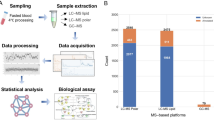Abstract
The metabolic effects of local tumors on the whole system and the link between the tumor microenvironment and the systemic macroenvironment are poorly known. In this study, we profiled the metabolites in tissues and plasma collected from patients with gastric cancer (GC), postoperative GC patients, and control patients with chronic superficial gastritis (CSG). The tissues and plasma of the GC patients showed distinctly different metabolic phenotypes from those of the CSG controls. Significantly elevated glycolysis, tricarboxylic acid cycle (TCA), and amino acids turnover characterized metabolism of GC tissues; and greater metabolic perturbation were observed in GC tissues than that in GC plasma, both compared with the controls. Remarkably, the levels of the discriminatory metabolites characterizing GC were not positively correlated in tissues and plasmas. For examples, TCA intermediates, lactate, amino acids and free fatty acids were more abundant in the tissues but less concentrated in plasma relative to their CSG controls; while glucose was lower in both the tissues and plasma of GC patients than the controls. For the first time we showed a balance profile of metabolites between tumor microenvironment and the systemic environment. Additionally, the surgical removal of the GC tissue restored the levels of the molecules cited above to different extent in postoperative GC patients, indicating the relationship of systemic environment to tumor microenvironment. The results further suggested that metabolomic analysis of intact tissues is potentially an alternative technique for the clinical diagnosis of GC.



Similar content being viewed by others
References
Aa, J., Trygg, J., Gullberg, J., et al. (2005). Extraction and GC/MS analysis of the human blood plasma metabolome. Analytical Chemistry, 77, 8086–8094.
Ahn, J., Park, I. S., Lee, K. S., et al. (2001). Fatty acid patterns in gastric mucosa of stomach cancer patients. Yonsei Medical Journal, 42, 220–226.
Averous, J., & Proud, C. G. (2006). When translation meets transformation: The mTOR story. Oncogene, 25, 6423–6435.
Clemens, M. J. (2004). Targets and mechanisms for the regulation of translation in malignant transformation. Oncogene, 23, 3180–3188.
Denkert, C., Budczies, J., Weichert, W., et al. (2008). Metabolite profiling of human colon carcinoma—deregulation of TCA cycle and amino acid turnover. Mol Cancer, 7, 72.
Gatenby, R. A., & Gillies, R. J. (2004). Why do cancers have high aerobic glycolysis? Nature Reviews Cancer, 4, 891–899.
Gu, S., Aa, J., Wang, G., et al. (2010). Metabonomic profiling of liver metabolites by gas chromatography-mass spectrometry and its application to characterizing hyperlipidemia. Biomedical Chromatography, 24, 243–252.
Hirayama, A., Kami, K., Sugimoto, M., et al. (2009). Quantitative metabolome profiling of colon and stomach cancer microenvironment by capillary electrophoresis time-of-flight mass spectrometry. Cancer Research, 69, 4918–4925.
Jonsson, P., Johansson, A. I., Gullberg, J., et al. (2005). High-throughput data analysis for detecting and identifying differences between samples in GC/MS-based metabolomic analyses. Analytical Chemistry, 77, 5635–5642.
Kuhajda, F. P. (2000). Fatty-acid synthase and human cancer: New perspectives on its role in tumor biology. Nutrition, 16, 202–208.
Milgraum, L. Z., Witters, L. A., Pasternack, G. R., et al. (1997). Enzymes of the fatty acid synthesis pathway are highly expressed in in situ breast carcinoma. Clinical Cancer Research, 3, 2115–2120.
Parkin, D. M., Bray, F., Ferlay, J., et al. (2005). Global cancer statistics, 2002. CA Cancer J Clinicians, 55, 74–108.
Rahman, L., Voeller, D., Rahman, M., et al. (2004). Thymidylate synthase as an oncogene: A novel role for an essential DNA synthesis enzyme. Cancer Cell, 5, 341–351.
Trygg, J., Holmes, E., & Lundstedt, T. (2007). Chemometrics in metabonomics. Journal of Proteome Research, 6, 469–479.
Voeller, D., Rahman, L., & Zajac-Kaye, M. (2004). Elevated levels of thymidylate synthase linked to neoplastic transformation of mammalian cells. Cell Cycle, 3, 1005–1007.
Warburg, O. (1956). On the origin of cancer cells. Science, 123, 309–314.
Weber, G., Singhal, R. L., Stamm, N. B., et al. (1966). Synchronous behavior pattern of key glycolytic enzymes: Glucokinase, phosphofructokinase, and pyruvate kinase. Advances in Enzyme Regulation, 4, 59–81.
Zha, W., Aa, J., Wang, G., et al. (2009). Metabonomic characterization of early atherosclerosis in hamsters with induced cholesterol. Biomarkers, 14, 372–380.
Acknowledgments
Grant supports: the National Key New Drug Creation Special Programs (2009ZX09304-001 and 2009ZX09502-004), National Key fundamental research ‘973’ projects (2011CB505300 and 2011CB505303), National Natural Science Foundation of the People’s Republic of China (81072692), Jiangsu Educational Nature Science Foundation (10KJB320007).
Conflicts of interest statement
The authors declare no conflict of interest.
Author information
Authors and Affiliations
Corresponding author
Additional information
Lianzhen Yu—Co-first author.
Electronic supplementary material
Below is the link to the electronic supplementary material.
Rights and permissions
About this article
Cite this article
Aa, J., Yu, L., Sun, M. et al. Metabolic features of the tumor microenvironment of gastric cancer and the link to the systemic macroenvironment. Metabolomics 8, 164–173 (2012). https://doi.org/10.1007/s11306-011-0297-0
Received:
Accepted:
Published:
Issue Date:
DOI: https://doi.org/10.1007/s11306-011-0297-0




